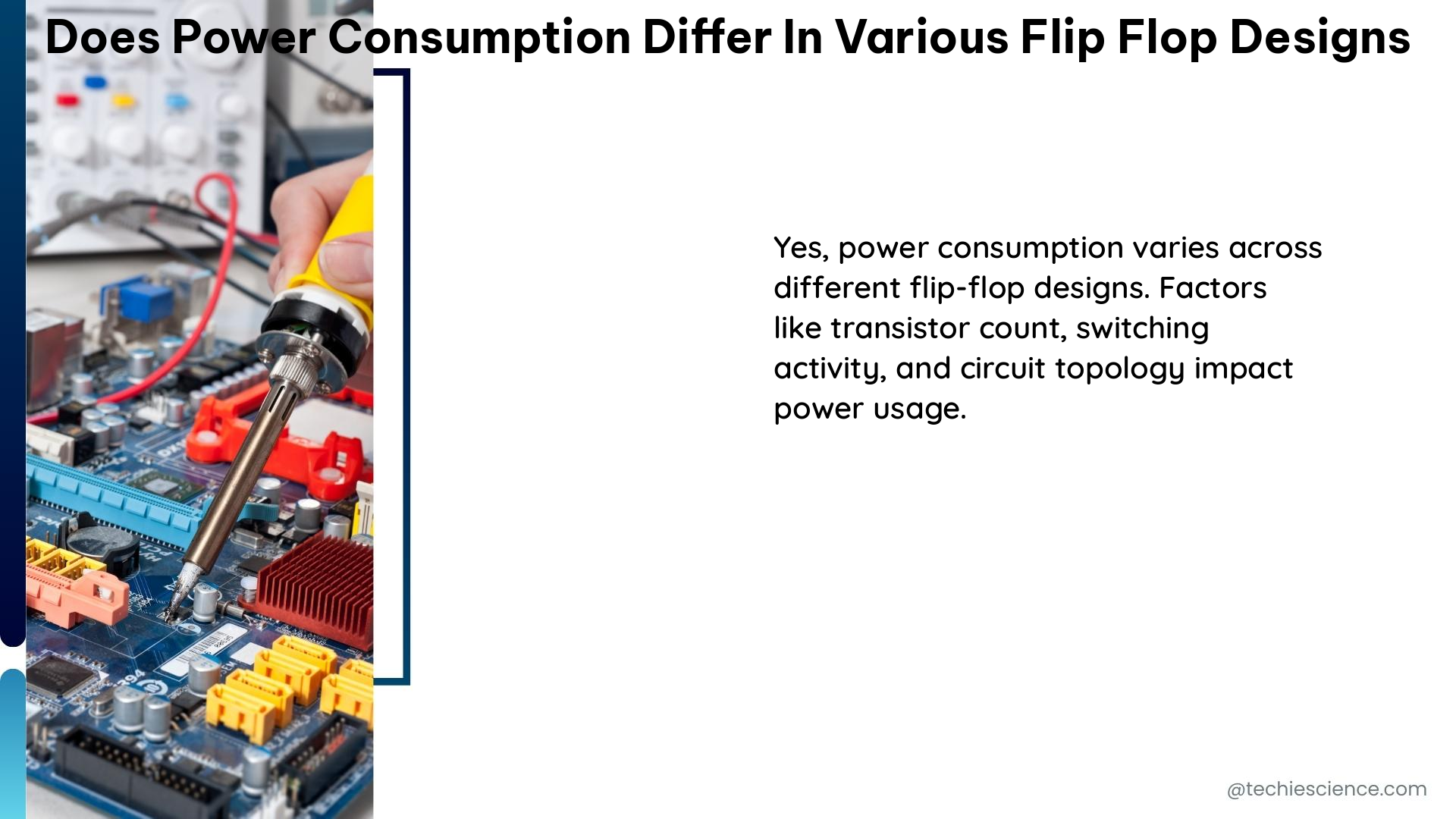Power consumption is a critical factor in the design and implementation of digital circuits, particularly in applications where energy efficiency is a primary concern, such as mobile devices, wearables, and IoT (Internet of Things) applications. One of the key components that contribute to the overall power consumption of a digital system is the flip-flop, a fundamental building block used for storing and synchronizing data.
Understanding Flip-Flop Power Consumption
Flip-flops can be designed in various topologies, each with its own characteristics and power consumption profile. The primary factors that contribute to the power consumption of flip-flops include:
- Design Topology: The specific circuit design of the flip-flop, such as the use of transmission gates, static logic, or dynamic logic, can significantly impact its power consumption.
- Data Pattern: The switching activity of the input data can greatly influence the power consumption of the flip-flop. Certain data patterns may result in higher switching activity and, consequently, higher power consumption.
- Clock Frequency: The frequency of the clock signal driving the flip-flop is directly proportional to its power consumption. Higher clock frequencies generally lead to increased power consumption.
Evaluating Power Consumption in Flip-Flop Designs

Researchers have conducted extensive studies to analyze and compare the power consumption of various flip-flop designs. Here are some key findings:
Low-Swing Clock Double-Edge Triggered Flip-Flop (LSDFF)
A study presented in [1] introduces a low-swing clock double-edge triggered flip-flop (LSDFF) design that can significantly reduce power consumption compared to conventional flip-flops. The LSDFF achieves this reduction by using a low-swing clock signal, which decreases the power consumption of the clock network.
The LSDFF design was evaluated under different supply voltage and temperature conditions, and the results showed that it can achieve a power-delay product (PDP) reduction of up to 50% compared to a conventional double-edge triggered flip-flop (DETFF).
Semi-Transparent Flip-Flop Structures
In [2], a novel semi-transparent structure is proposed for implementing both single-edge and dual-edge triggered flip-flops. These novel flip-flop designs can achieve a considerable reduction in power consumption compared to conventional flip-flop designs.
The semi-transparent flip-flops leverage a unique circuit topology that reduces the number of transistors and the overall switching activity, leading to lower power consumption. Simulation results demonstrate power savings of up to 30% compared to traditional flip-flop designs.
Comprehensive Flip-Flop Power Consumption Analysis
A comprehensive survey and evaluation of low-power flip-flops is presented in [3]. The study examines various flip-flop designs, including dynamic, static, and transmission gate flip-flops, and analyzes their power consumption characteristics.
The study highlights the key features of these flip-flops and evaluates them based on timing characteristics, power consumption, and other metrics. The findings provide valuable insights into the power consumption trade-offs among different flip-flop design approaches.
Factors Affecting Flip-Flop Power Consumption
The power consumption of flip-flops can be influenced by several factors, including:
- Supply Voltage: Lower supply voltages generally lead to reduced power consumption, as the dynamic power dissipation is proportional to the square of the supply voltage.
- Temperature: Variations in temperature can impact the power consumption of flip-flops due to changes in transistor characteristics and leakage currents.
- Process Variations: Differences in the manufacturing process can result in variations in transistor parameters, which can affect the power consumption of flip-flops.
- Data Patterns: The switching activity of the input data can significantly influence the power consumption of flip-flops. Certain data patterns may result in higher switching activity and, consequently, higher power consumption.
Reliability Considerations
In addition to power consumption, the reliability of flip-flops is also an important factor to consider. A study by Minghe Shao [4] evaluates the functional reliability of various flip-flop designs under different temperature and supply voltage conditions.
The study uses corner and Monte-Carlo simulations to quantitatively assess the reliability of flip-flops and discusses the failure mechanisms that can occur, such as setup/hold time violations and metastability issues. Understanding the reliability implications of different flip-flop designs is crucial for ensuring the overall robustness and dependability of the digital system.
Conclusion
Power consumption is a critical design consideration in modern digital systems, and the choice of flip-flop design can have a significant impact on the overall power consumption of the system. Researchers have explored various flip-flop topologies, such as low-swing clock designs and semi-transparent structures, that can achieve substantial reductions in power consumption compared to conventional flip-flop designs.
By understanding the factors that influence flip-flop power consumption, including design topology, data patterns, and clock frequency, as well as considering reliability aspects, designers can make informed decisions to optimize the power efficiency and performance of their digital circuits.
References
- Minghe Shao, “Energy-Efficient Flip-Flop Design for Dynamic Voltage Scaling and Circulating-Temperature Applications,” University of Pittsburgh, 2021. [Online]. Available: https://d-scholarship.pitt.edu/40435/1/ShaoMinghe_etdPitt2021.pdf
- A. Morgenshtein, A. Fish, and I. A. Wagner, “Gate-Diffusion Input (GDI) – A Novel Power Efficient Method for Digital Circuits: A Design Methodology,” 2002 14th Annual IEEE International ASIC/SOC Conference (IEEE Cat. No.01TH8558), 2002, pp. 39-43, doi: 10.1109/ASIC.2002.1158970.
- H. Mahmoodi-Meimand and K. Roy, “Survey of Low-Power Flip-Flops in Deep Submicron Technology,” 2002 International Symposium on Low Power Electronics and Design, 2002, pp. 291-296, doi: 10.1109/LPE.2002.146725.
- Minghe Shao, “Energy-Efficient Flip-Flop Design for Dynamic Voltage Scaling and Circulating-Temperature Applications,” University of Pittsburgh, 2021. [Online]. Available: https://d-scholarship.pitt.edu/40435/1/ShaoMinghe_etdPitt2021.pdf

The lambdageeks.com Core SME Team is a group of experienced subject matter experts from diverse scientific and technical fields including Physics, Chemistry, Technology,Electronics & Electrical Engineering, Automotive, Mechanical Engineering. Our team collaborates to create high-quality, well-researched articles on a wide range of science and technology topics for the lambdageeks.com website.
All Our Senior SME are having more than 7 Years of experience in the respective fields . They are either Working Industry Professionals or assocaited With different Universities. Refer Our Authors Page to get to know About our Core SMEs.